Leadership Styles & Teachers' Job Satisfaction in Schools, Ethiopia
VerifiedAdded on 2023/05/06
|99
|35832
|339
Essay
AI Summary
This essay investigates the influence of leadership styles on teachers' job satisfaction, particularly within secondary and preparatory schools. It begins by establishing the importance of leadership in education and its impact on teacher motivation and performance. The study acknowledges the various leadership styles, such as autocratic, democratic, and transformational, and their potential effects on job satisfaction. The problem statement highlights the ongoing need to identify leadership styles that foster teacher satisfaction, referencing the Ethiopian Education and Training Policy's emphasis on democratic and effective management. The research aims to contribute to the understanding of how different leadership approaches affect teachers' motivation and job satisfaction in the Gamo Gofa Zone, ultimately seeking to inform and improve educational leadership practices.
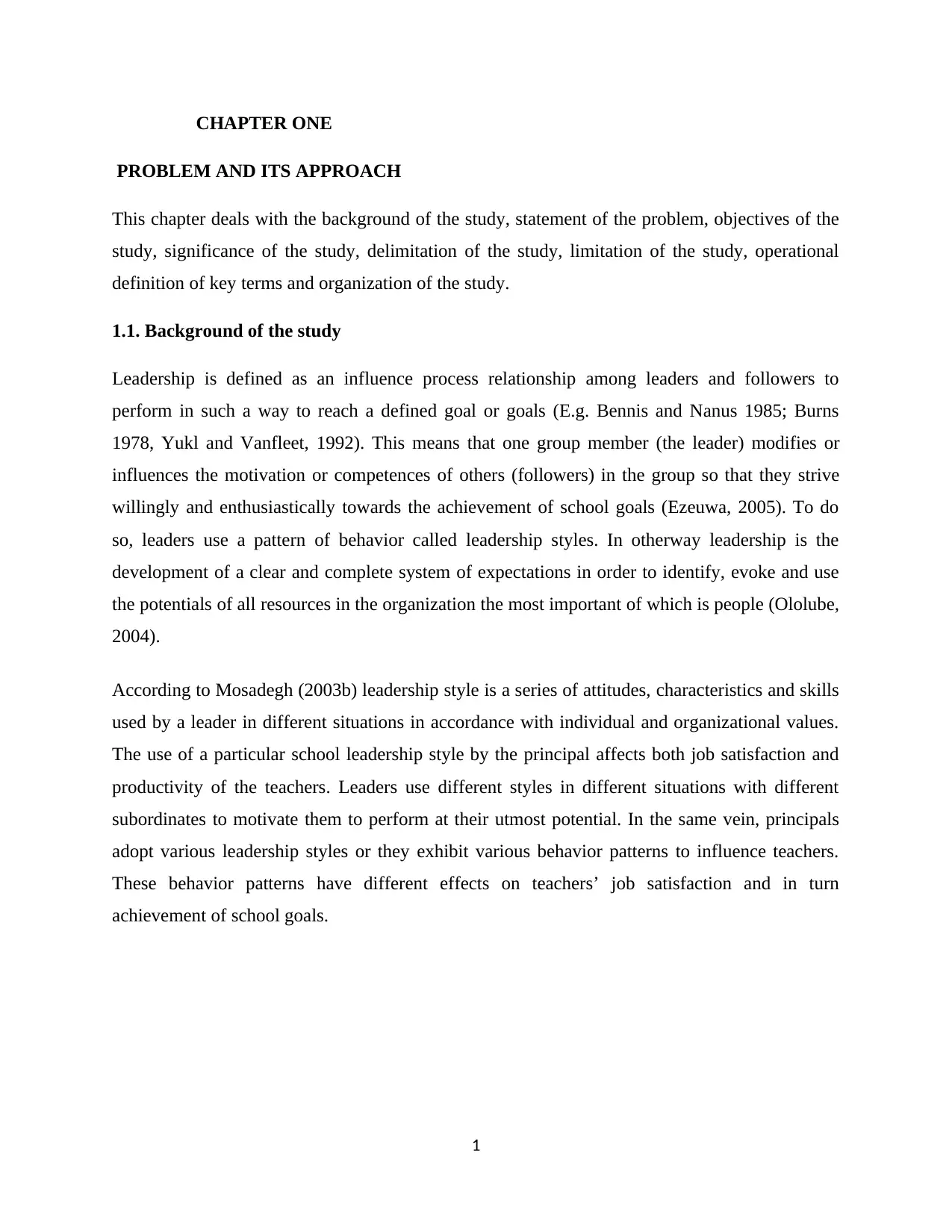
CHAPTER ONE
PROBLEM AND ITS APPROACH
This chapter deals with the background of the study, statement of the problem, objectives of the
study, significance of the study, delimitation of the study, limitation of the study, operational
definition of key terms and organization of the study.
1.1. Background of the study
Leadership is defined as an influence process relationship among leaders and followers to
perform in such a way to reach a defined goal or goals (E.g. Bennis and Nanus 1985; Burns
1978, Yukl and Vanfleet, 1992). This means that one group member (the leader) modifies or
influences the motivation or competences of others (followers) in the group so that they strive
willingly and enthusiastically towards the achievement of school goals (Ezeuwa, 2005). To do
so, leaders use a pattern of behavior called leadership styles. In otherway leadership is the
development of a clear and complete system of expectations in order to identify, evoke and use
the potentials of all resources in the organization the most important of which is people (Ololube,
2004).
According to Mosadegh (2003b) leadership style is a series of attitudes, characteristics and skills
used by a leader in different situations in accordance with individual and organizational values.
The use of a particular school leadership style by the principal affects both job satisfaction and
productivity of the teachers. Leaders use different styles in different situations with different
subordinates to motivate them to perform at their utmost potential. In the same vein, principals
adopt various leadership styles or they exhibit various behavior patterns to influence teachers.
These behavior patterns have different effects on teachers’ job satisfaction and in turn
achievement of school goals.
1
PROBLEM AND ITS APPROACH
This chapter deals with the background of the study, statement of the problem, objectives of the
study, significance of the study, delimitation of the study, limitation of the study, operational
definition of key terms and organization of the study.
1.1. Background of the study
Leadership is defined as an influence process relationship among leaders and followers to
perform in such a way to reach a defined goal or goals (E.g. Bennis and Nanus 1985; Burns
1978, Yukl and Vanfleet, 1992). This means that one group member (the leader) modifies or
influences the motivation or competences of others (followers) in the group so that they strive
willingly and enthusiastically towards the achievement of school goals (Ezeuwa, 2005). To do
so, leaders use a pattern of behavior called leadership styles. In otherway leadership is the
development of a clear and complete system of expectations in order to identify, evoke and use
the potentials of all resources in the organization the most important of which is people (Ololube,
2004).
According to Mosadegh (2003b) leadership style is a series of attitudes, characteristics and skills
used by a leader in different situations in accordance with individual and organizational values.
The use of a particular school leadership style by the principal affects both job satisfaction and
productivity of the teachers. Leaders use different styles in different situations with different
subordinates to motivate them to perform at their utmost potential. In the same vein, principals
adopt various leadership styles or they exhibit various behavior patterns to influence teachers.
These behavior patterns have different effects on teachers’ job satisfaction and in turn
achievement of school goals.
1
Paraphrase This Document
Need a fresh take? Get an instant paraphrase of this document with our AI Paraphraser
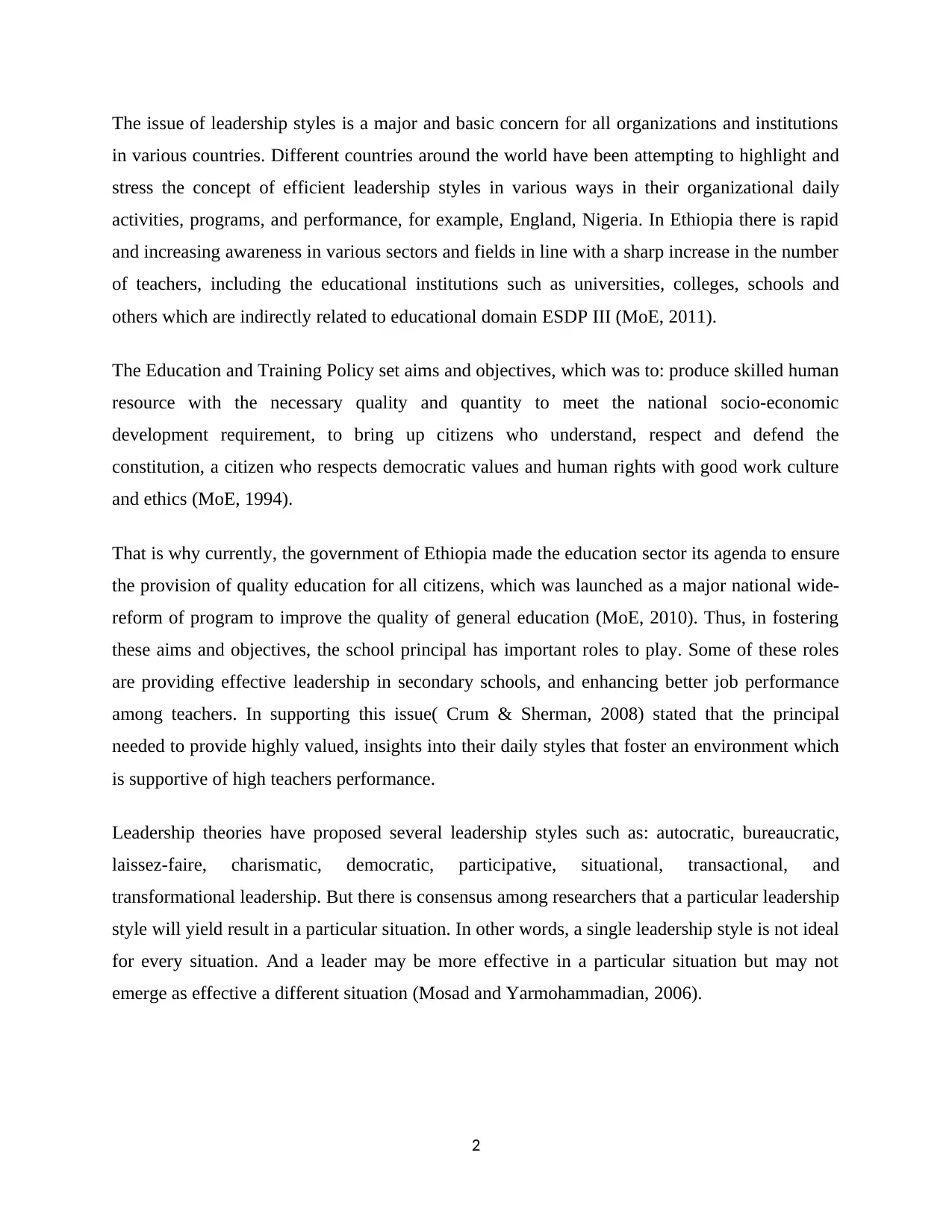
The issue of leadership styles is a major and basic concern for all organizations and institutions
in various countries. Different countries around the world have been attempting to highlight and
stress the concept of efficient leadership styles in various ways in their organizational daily
activities, programs, and performance, for example, England, Nigeria. In Ethiopia there is rapid
and increasing awareness in various sectors and fields in line with a sharp increase in the number
of teachers, including the educational institutions such as universities, colleges, schools and
others which are indirectly related to educational domain ESDP III (MoE, 2011).
The Education and Training Policy set aims and objectives, which was to: produce skilled human
resource with the necessary quality and quantity to meet the national socio-economic
development requirement, to bring up citizens who understand, respect and defend the
constitution, a citizen who respects democratic values and human rights with good work culture
and ethics (MoE, 1994).
That is why currently, the government of Ethiopia made the education sector its agenda to ensure
the provision of quality education for all citizens, which was launched as a major national wide-
reform of program to improve the quality of general education (MoE, 2010). Thus, in fostering
these aims and objectives, the school principal has important roles to play. Some of these roles
are providing effective leadership in secondary schools, and enhancing better job performance
among teachers. In supporting this issue( Crum & Sherman, 2008) stated that the principal
needed to provide highly valued, insights into their daily styles that foster an environment which
is supportive of high teachers performance.
Leadership theories have proposed several leadership styles such as: autocratic, bureaucratic,
laissez-faire, charismatic, democratic, participative, situational, transactional, and
transformational leadership. But there is consensus among researchers that a particular leadership
style will yield result in a particular situation. In other words, a single leadership style is not ideal
for every situation. And a leader may be more effective in a particular situation but may not
emerge as effective a different situation (Mosad and Yarmohammadian, 2006).
2
in various countries. Different countries around the world have been attempting to highlight and
stress the concept of efficient leadership styles in various ways in their organizational daily
activities, programs, and performance, for example, England, Nigeria. In Ethiopia there is rapid
and increasing awareness in various sectors and fields in line with a sharp increase in the number
of teachers, including the educational institutions such as universities, colleges, schools and
others which are indirectly related to educational domain ESDP III (MoE, 2011).
The Education and Training Policy set aims and objectives, which was to: produce skilled human
resource with the necessary quality and quantity to meet the national socio-economic
development requirement, to bring up citizens who understand, respect and defend the
constitution, a citizen who respects democratic values and human rights with good work culture
and ethics (MoE, 1994).
That is why currently, the government of Ethiopia made the education sector its agenda to ensure
the provision of quality education for all citizens, which was launched as a major national wide-
reform of program to improve the quality of general education (MoE, 2010). Thus, in fostering
these aims and objectives, the school principal has important roles to play. Some of these roles
are providing effective leadership in secondary schools, and enhancing better job performance
among teachers. In supporting this issue( Crum & Sherman, 2008) stated that the principal
needed to provide highly valued, insights into their daily styles that foster an environment which
is supportive of high teachers performance.
Leadership theories have proposed several leadership styles such as: autocratic, bureaucratic,
laissez-faire, charismatic, democratic, participative, situational, transactional, and
transformational leadership. But there is consensus among researchers that a particular leadership
style will yield result in a particular situation. In other words, a single leadership style is not ideal
for every situation. And a leader may be more effective in a particular situation but may not
emerge as effective a different situation (Mosad and Yarmohammadian, 2006).
2
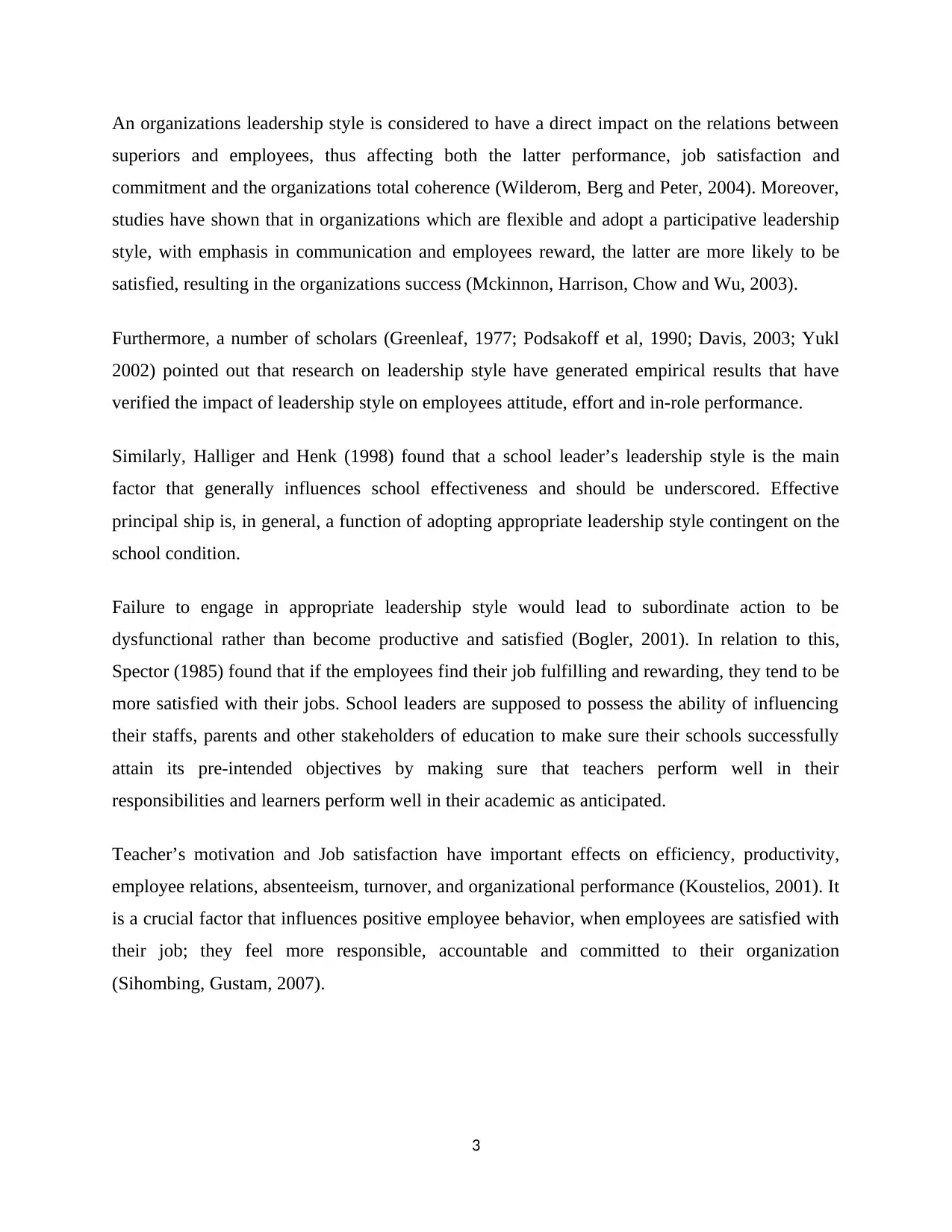
An organizations leadership style is considered to have a direct impact on the relations between
superiors and employees, thus affecting both the latter performance, job satisfaction and
commitment and the organizations total coherence (Wilderom, Berg and Peter, 2004). Moreover,
studies have shown that in organizations which are flexible and adopt a participative leadership
style, with emphasis in communication and employees reward, the latter are more likely to be
satisfied, resulting in the organizations success (Mckinnon, Harrison, Chow and Wu, 2003).
Furthermore, a number of scholars (Greenleaf, 1977; Podsakoff et al, 1990; Davis, 2003; Yukl
2002) pointed out that research on leadership style have generated empirical results that have
verified the impact of leadership style on employees attitude, effort and in-role performance.
Similarly, Halliger and Henk (1998) found that a school leader’s leadership style is the main
factor that generally influences school effectiveness and should be underscored. Effective
principal ship is, in general, a function of adopting appropriate leadership style contingent on the
school condition.
Failure to engage in appropriate leadership style would lead to subordinate action to be
dysfunctional rather than become productive and satisfied (Bogler, 2001). In relation to this,
Spector (1985) found that if the employees find their job fulfilling and rewarding, they tend to be
more satisfied with their jobs. School leaders are supposed to possess the ability of influencing
their staffs, parents and other stakeholders of education to make sure their schools successfully
attain its pre-intended objectives by making sure that teachers perform well in their
responsibilities and learners perform well in their academic as anticipated.
Teacher’s motivation and Job satisfaction have important effects on efficiency, productivity,
employee relations, absenteeism, turnover, and organizational performance (Koustelios, 2001). It
is a crucial factor that influences positive employee behavior, when employees are satisfied with
their job; they feel more responsible, accountable and committed to their organization
(Sihombing, Gustam, 2007).
3
superiors and employees, thus affecting both the latter performance, job satisfaction and
commitment and the organizations total coherence (Wilderom, Berg and Peter, 2004). Moreover,
studies have shown that in organizations which are flexible and adopt a participative leadership
style, with emphasis in communication and employees reward, the latter are more likely to be
satisfied, resulting in the organizations success (Mckinnon, Harrison, Chow and Wu, 2003).
Furthermore, a number of scholars (Greenleaf, 1977; Podsakoff et al, 1990; Davis, 2003; Yukl
2002) pointed out that research on leadership style have generated empirical results that have
verified the impact of leadership style on employees attitude, effort and in-role performance.
Similarly, Halliger and Henk (1998) found that a school leader’s leadership style is the main
factor that generally influences school effectiveness and should be underscored. Effective
principal ship is, in general, a function of adopting appropriate leadership style contingent on the
school condition.
Failure to engage in appropriate leadership style would lead to subordinate action to be
dysfunctional rather than become productive and satisfied (Bogler, 2001). In relation to this,
Spector (1985) found that if the employees find their job fulfilling and rewarding, they tend to be
more satisfied with their jobs. School leaders are supposed to possess the ability of influencing
their staffs, parents and other stakeholders of education to make sure their schools successfully
attain its pre-intended objectives by making sure that teachers perform well in their
responsibilities and learners perform well in their academic as anticipated.
Teacher’s motivation and Job satisfaction have important effects on efficiency, productivity,
employee relations, absenteeism, turnover, and organizational performance (Koustelios, 2001). It
is a crucial factor that influences positive employee behavior, when employees are satisfied with
their job; they feel more responsible, accountable and committed to their organization
(Sihombing, Gustam, 2007).
3
⊘ This is a preview!⊘
Do you want full access?
Subscribe today to unlock all pages.

Trusted by 1+ million students worldwide
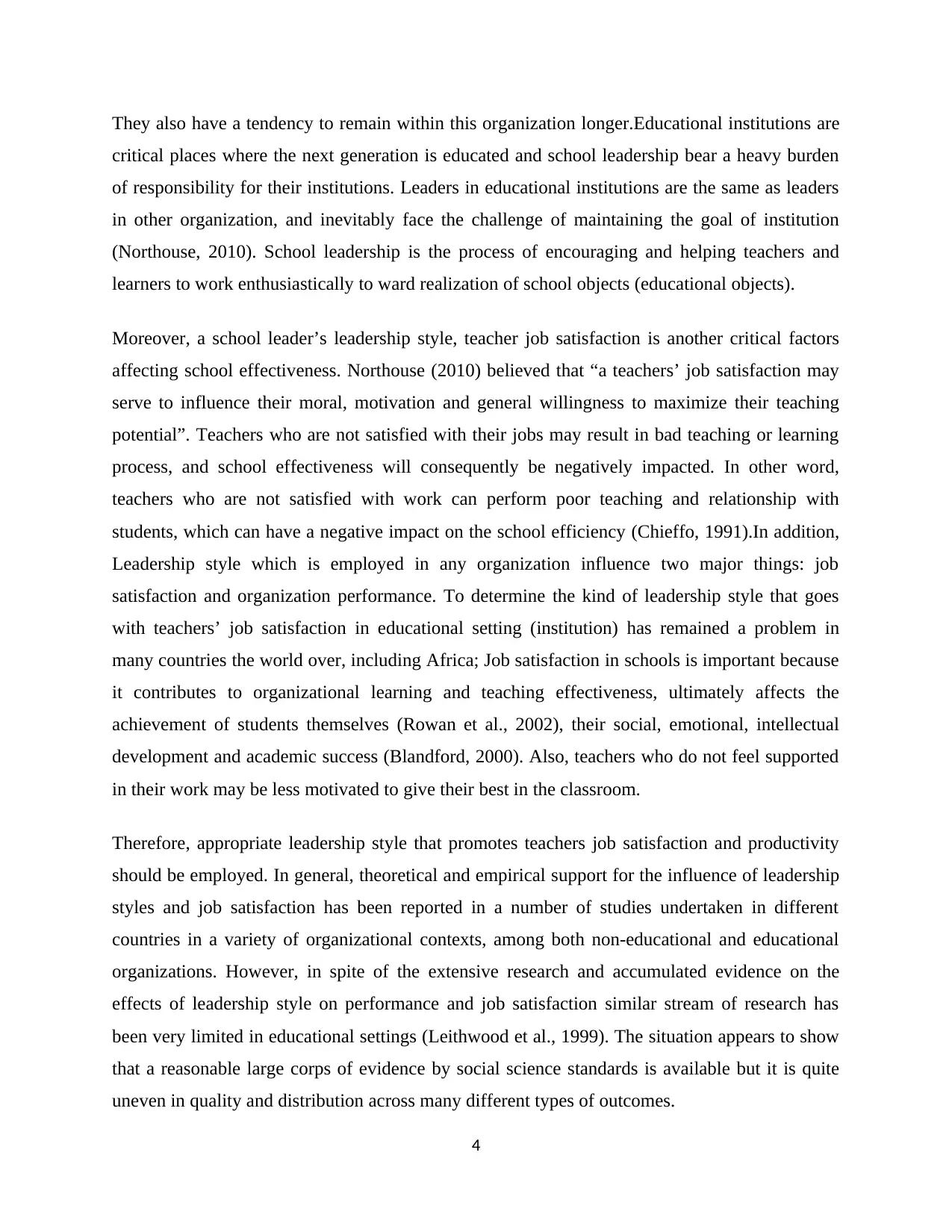
They also have a tendency to remain within this organization longer.Educational institutions are
critical places where the next generation is educated and school leadership bear a heavy burden
of responsibility for their institutions. Leaders in educational institutions are the same as leaders
in other organization, and inevitably face the challenge of maintaining the goal of institution
(Northouse, 2010). School leadership is the process of encouraging and helping teachers and
learners to work enthusiastically to ward realization of school objects (educational objects).
Moreover, a school leader’s leadership style, teacher job satisfaction is another critical factors
affecting school effectiveness. Northouse (2010) believed that “a teachers’ job satisfaction may
serve to influence their moral, motivation and general willingness to maximize their teaching
potential”. Teachers who are not satisfied with their jobs may result in bad teaching or learning
process, and school effectiveness will consequently be negatively impacted. In other word,
teachers who are not satisfied with work can perform poor teaching and relationship with
students, which can have a negative impact on the school efficiency (Chieffo, 1991).In addition,
Leadership style which is employed in any organization influence two major things: job
satisfaction and organization performance. To determine the kind of leadership style that goes
with teachers’ job satisfaction in educational setting (institution) has remained a problem in
many countries the world over, including Africa; Job satisfaction in schools is important because
it contributes to organizational learning and teaching effectiveness, ultimately affects the
achievement of students themselves (Rowan et al., 2002), their social, emotional, intellectual
development and academic success (Blandford, 2000). Also, teachers who do not feel supported
in their work may be less motivated to give their best in the classroom.
Therefore, appropriate leadership style that promotes teachers job satisfaction and productivity
should be employed. In general, theoretical and empirical support for the influence of leadership
styles and job satisfaction has been reported in a number of studies undertaken in different
countries in a variety of organizational contexts, among both non-educational and educational
organizations. However, in spite of the extensive research and accumulated evidence on the
effects of leadership style on performance and job satisfaction similar stream of research has
been very limited in educational settings (Leithwood et al., 1999). The situation appears to show
that a reasonable large corps of evidence by social science standards is available but it is quite
uneven in quality and distribution across many different types of outcomes.
4
critical places where the next generation is educated and school leadership bear a heavy burden
of responsibility for their institutions. Leaders in educational institutions are the same as leaders
in other organization, and inevitably face the challenge of maintaining the goal of institution
(Northouse, 2010). School leadership is the process of encouraging and helping teachers and
learners to work enthusiastically to ward realization of school objects (educational objects).
Moreover, a school leader’s leadership style, teacher job satisfaction is another critical factors
affecting school effectiveness. Northouse (2010) believed that “a teachers’ job satisfaction may
serve to influence their moral, motivation and general willingness to maximize their teaching
potential”. Teachers who are not satisfied with their jobs may result in bad teaching or learning
process, and school effectiveness will consequently be negatively impacted. In other word,
teachers who are not satisfied with work can perform poor teaching and relationship with
students, which can have a negative impact on the school efficiency (Chieffo, 1991).In addition,
Leadership style which is employed in any organization influence two major things: job
satisfaction and organization performance. To determine the kind of leadership style that goes
with teachers’ job satisfaction in educational setting (institution) has remained a problem in
many countries the world over, including Africa; Job satisfaction in schools is important because
it contributes to organizational learning and teaching effectiveness, ultimately affects the
achievement of students themselves (Rowan et al., 2002), their social, emotional, intellectual
development and academic success (Blandford, 2000). Also, teachers who do not feel supported
in their work may be less motivated to give their best in the classroom.
Therefore, appropriate leadership style that promotes teachers job satisfaction and productivity
should be employed. In general, theoretical and empirical support for the influence of leadership
styles and job satisfaction has been reported in a number of studies undertaken in different
countries in a variety of organizational contexts, among both non-educational and educational
organizations. However, in spite of the extensive research and accumulated evidence on the
effects of leadership style on performance and job satisfaction similar stream of research has
been very limited in educational settings (Leithwood et al., 1999). The situation appears to show
that a reasonable large corps of evidence by social science standards is available but it is quite
uneven in quality and distribution across many different types of outcomes.
4
Paraphrase This Document
Need a fresh take? Get an instant paraphrase of this document with our AI Paraphraser
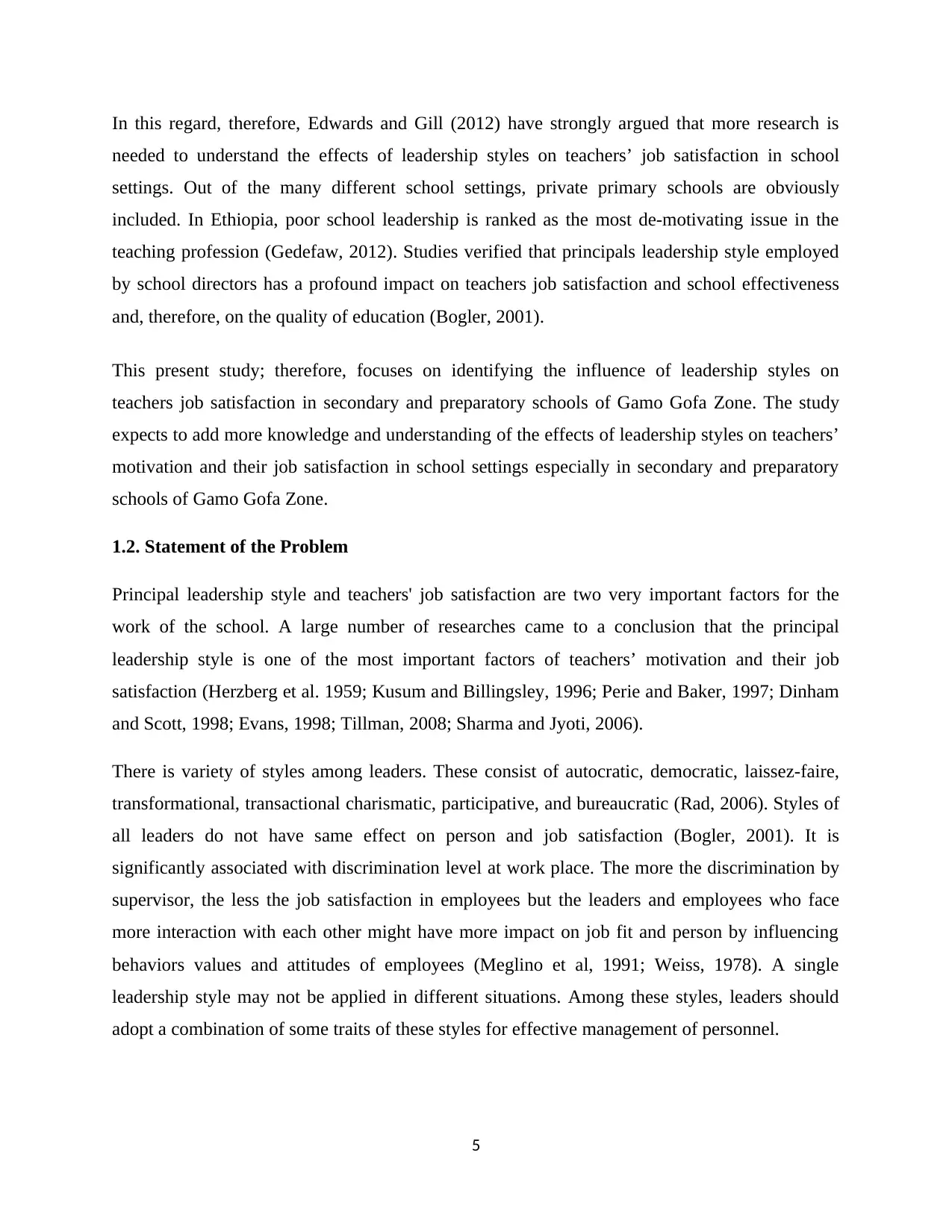
In this regard, therefore, Edwards and Gill (2012) have strongly argued that more research is
needed to understand the effects of leadership styles on teachers’ job satisfaction in school
settings. Out of the many different school settings, private primary schools are obviously
included. In Ethiopia, poor school leadership is ranked as the most de-motivating issue in the
teaching profession (Gedefaw, 2012). Studies verified that principals leadership style employed
by school directors has a profound impact on teachers job satisfaction and school effectiveness
and, therefore, on the quality of education (Bogler, 2001).
This present study; therefore, focuses on identifying the influence of leadership styles on
teachers job satisfaction in secondary and preparatory schools of Gamo Gofa Zone. The study
expects to add more knowledge and understanding of the effects of leadership styles on teachers’
motivation and their job satisfaction in school settings especially in secondary and preparatory
schools of Gamo Gofa Zone.
1.2. Statement of the Problem
Principal leadership style and teachers' job satisfaction are two very important factors for the
work of the school. A large number of researches came to a conclusion that the principal
leadership style is one of the most important factors of teachers’ motivation and their job
satisfaction (Herzberg et al. 1959; Kusum and Billingsley, 1996; Perie and Baker, 1997; Dinham
and Scott, 1998; Evans, 1998; Tillman, 2008; Sharma and Jyoti, 2006).
There is variety of styles among leaders. These consist of autocratic, democratic, laissez-faire,
transformational, transactional charismatic, participative, and bureaucratic (Rad, 2006). Styles of
all leaders do not have same effect on person and job satisfaction (Bogler, 2001). It is
significantly associated with discrimination level at work place. The more the discrimination by
supervisor, the less the job satisfaction in employees but the leaders and employees who face
more interaction with each other might have more impact on job fit and person by influencing
behaviors values and attitudes of employees (Meglino et al, 1991; Weiss, 1978). A single
leadership style may not be applied in different situations. Among these styles, leaders should
adopt a combination of some traits of these styles for effective management of personnel.
5
needed to understand the effects of leadership styles on teachers’ job satisfaction in school
settings. Out of the many different school settings, private primary schools are obviously
included. In Ethiopia, poor school leadership is ranked as the most de-motivating issue in the
teaching profession (Gedefaw, 2012). Studies verified that principals leadership style employed
by school directors has a profound impact on teachers job satisfaction and school effectiveness
and, therefore, on the quality of education (Bogler, 2001).
This present study; therefore, focuses on identifying the influence of leadership styles on
teachers job satisfaction in secondary and preparatory schools of Gamo Gofa Zone. The study
expects to add more knowledge and understanding of the effects of leadership styles on teachers’
motivation and their job satisfaction in school settings especially in secondary and preparatory
schools of Gamo Gofa Zone.
1.2. Statement of the Problem
Principal leadership style and teachers' job satisfaction are two very important factors for the
work of the school. A large number of researches came to a conclusion that the principal
leadership style is one of the most important factors of teachers’ motivation and their job
satisfaction (Herzberg et al. 1959; Kusum and Billingsley, 1996; Perie and Baker, 1997; Dinham
and Scott, 1998; Evans, 1998; Tillman, 2008; Sharma and Jyoti, 2006).
There is variety of styles among leaders. These consist of autocratic, democratic, laissez-faire,
transformational, transactional charismatic, participative, and bureaucratic (Rad, 2006). Styles of
all leaders do not have same effect on person and job satisfaction (Bogler, 2001). It is
significantly associated with discrimination level at work place. The more the discrimination by
supervisor, the less the job satisfaction in employees but the leaders and employees who face
more interaction with each other might have more impact on job fit and person by influencing
behaviors values and attitudes of employees (Meglino et al, 1991; Weiss, 1978). A single
leadership style may not be applied in different situations. Among these styles, leaders should
adopt a combination of some traits of these styles for effective management of personnel.
5
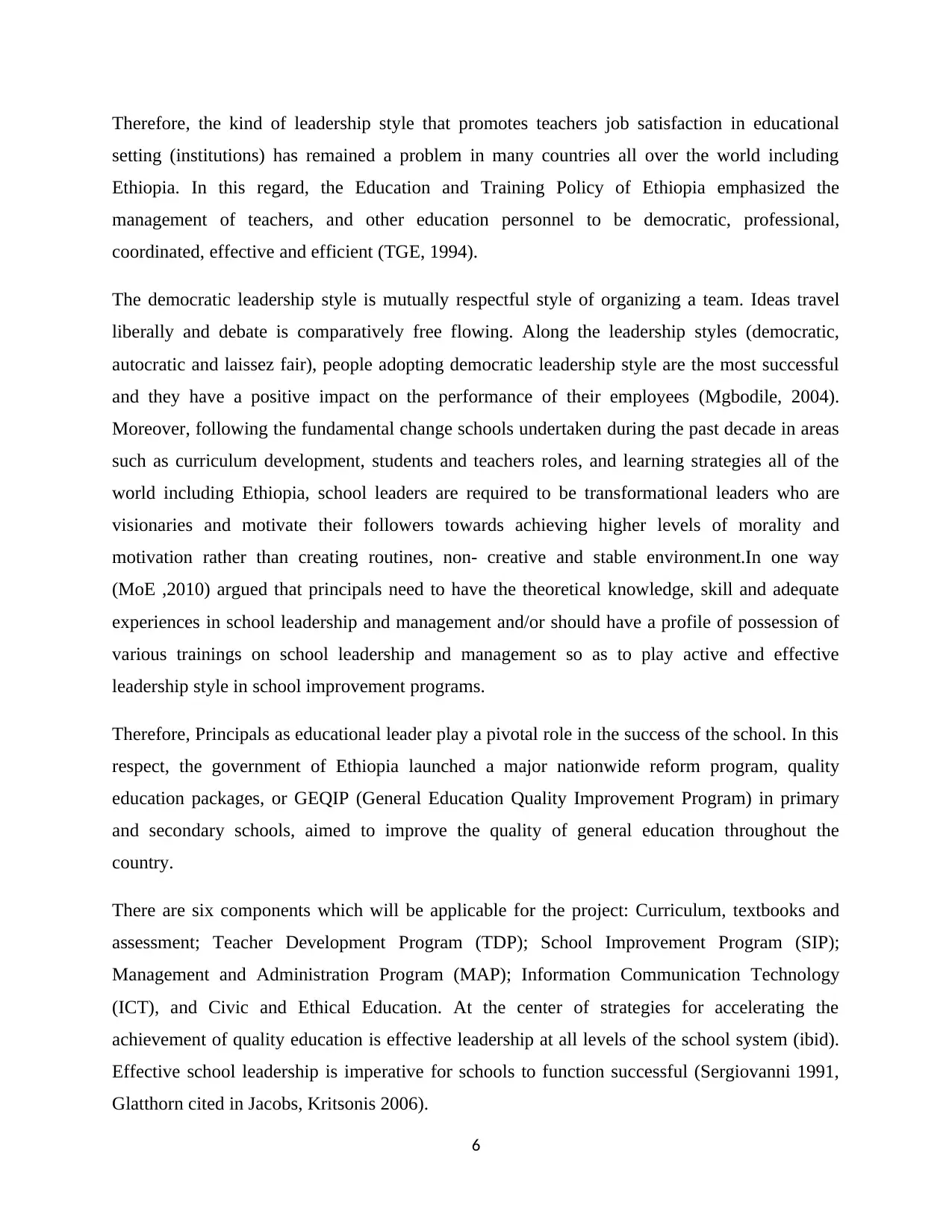
Therefore, the kind of leadership style that promotes teachers job satisfaction in educational
setting (institutions) has remained a problem in many countries all over the world including
Ethiopia. In this regard, the Education and Training Policy of Ethiopia emphasized the
management of teachers, and other education personnel to be democratic, professional,
coordinated, effective and efficient (TGE, 1994).
The democratic leadership style is mutually respectful style of organizing a team. Ideas travel
liberally and debate is comparatively free flowing. Along the leadership styles (democratic,
autocratic and laissez fair), people adopting democratic leadership style are the most successful
and they have a positive impact on the performance of their employees (Mgbodile, 2004).
Moreover, following the fundamental change schools undertaken during the past decade in areas
such as curriculum development, students and teachers roles, and learning strategies all of the
world including Ethiopia, school leaders are required to be transformational leaders who are
visionaries and motivate their followers towards achieving higher levels of morality and
motivation rather than creating routines, non- creative and stable environment.In one way
(MoE ,2010) argued that principals need to have the theoretical knowledge, skill and adequate
experiences in school leadership and management and/or should have a profile of possession of
various trainings on school leadership and management so as to play active and effective
leadership style in school improvement programs.
Therefore, Principals as educational leader play a pivotal role in the success of the school. In this
respect, the government of Ethiopia launched a major nationwide reform program, quality
education packages, or GEQIP (General Education Quality Improvement Program) in primary
and secondary schools, aimed to improve the quality of general education throughout the
country.
There are six components which will be applicable for the project: Curriculum, textbooks and
assessment; Teacher Development Program (TDP); School Improvement Program (SIP);
Management and Administration Program (MAP); Information Communication Technology
(ICT), and Civic and Ethical Education. At the center of strategies for accelerating the
achievement of quality education is effective leadership at all levels of the school system (ibid).
Effective school leadership is imperative for schools to function successful (Sergiovanni 1991,
Glatthorn cited in Jacobs, Kritsonis 2006).
6
setting (institutions) has remained a problem in many countries all over the world including
Ethiopia. In this regard, the Education and Training Policy of Ethiopia emphasized the
management of teachers, and other education personnel to be democratic, professional,
coordinated, effective and efficient (TGE, 1994).
The democratic leadership style is mutually respectful style of organizing a team. Ideas travel
liberally and debate is comparatively free flowing. Along the leadership styles (democratic,
autocratic and laissez fair), people adopting democratic leadership style are the most successful
and they have a positive impact on the performance of their employees (Mgbodile, 2004).
Moreover, following the fundamental change schools undertaken during the past decade in areas
such as curriculum development, students and teachers roles, and learning strategies all of the
world including Ethiopia, school leaders are required to be transformational leaders who are
visionaries and motivate their followers towards achieving higher levels of morality and
motivation rather than creating routines, non- creative and stable environment.In one way
(MoE ,2010) argued that principals need to have the theoretical knowledge, skill and adequate
experiences in school leadership and management and/or should have a profile of possession of
various trainings on school leadership and management so as to play active and effective
leadership style in school improvement programs.
Therefore, Principals as educational leader play a pivotal role in the success of the school. In this
respect, the government of Ethiopia launched a major nationwide reform program, quality
education packages, or GEQIP (General Education Quality Improvement Program) in primary
and secondary schools, aimed to improve the quality of general education throughout the
country.
There are six components which will be applicable for the project: Curriculum, textbooks and
assessment; Teacher Development Program (TDP); School Improvement Program (SIP);
Management and Administration Program (MAP); Information Communication Technology
(ICT), and Civic and Ethical Education. At the center of strategies for accelerating the
achievement of quality education is effective leadership at all levels of the school system (ibid).
Effective school leadership is imperative for schools to function successful (Sergiovanni 1991,
Glatthorn cited in Jacobs, Kritsonis 2006).
6
⊘ This is a preview!⊘
Do you want full access?
Subscribe today to unlock all pages.

Trusted by 1+ million students worldwide
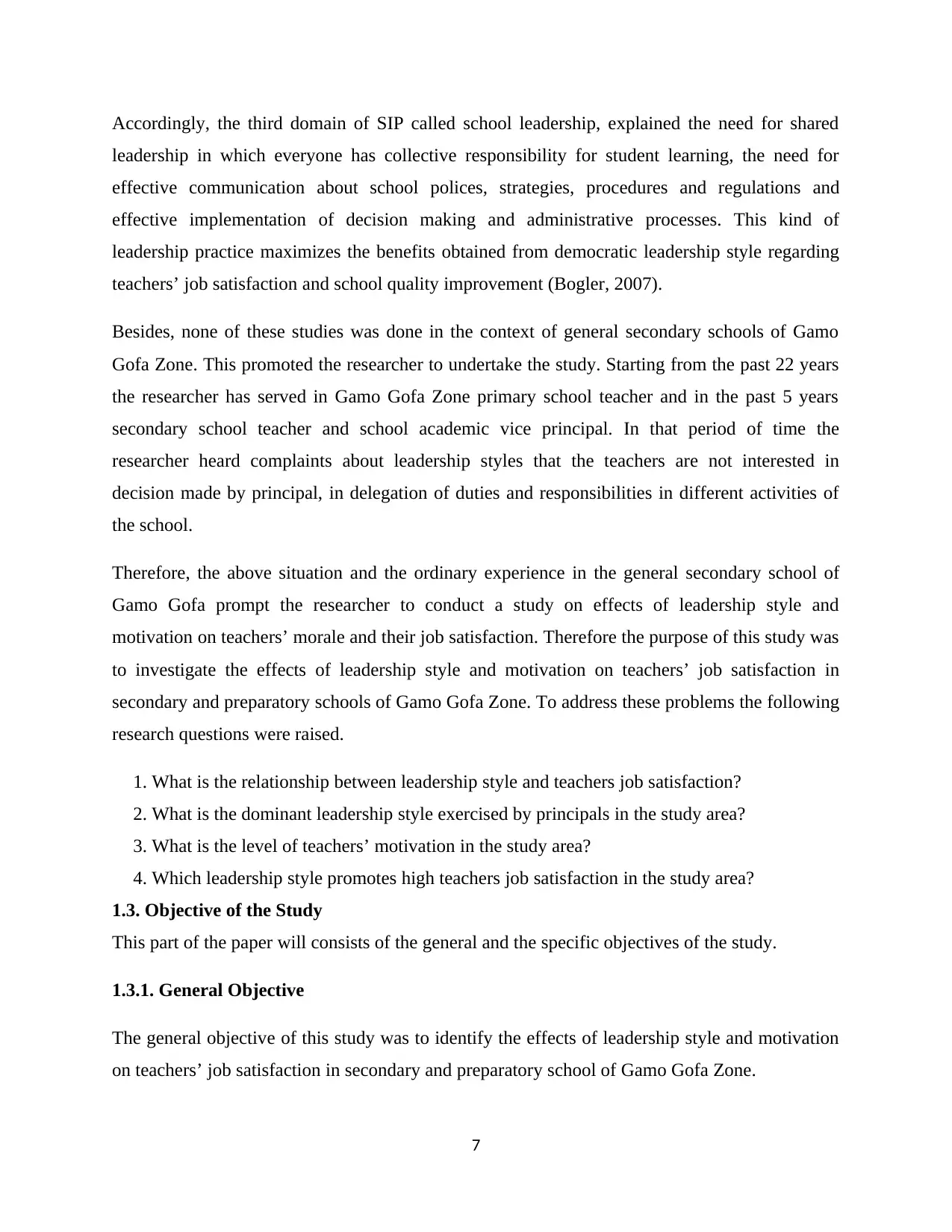
Accordingly, the third domain of SIP called school leadership, explained the need for shared
leadership in which everyone has collective responsibility for student learning, the need for
effective communication about school polices, strategies, procedures and regulations and
effective implementation of decision making and administrative processes. This kind of
leadership practice maximizes the benefits obtained from democratic leadership style regarding
teachers’ job satisfaction and school quality improvement (Bogler, 2007).
Besides, none of these studies was done in the context of general secondary schools of Gamo
Gofa Zone. This promoted the researcher to undertake the study. Starting from the past 22 years
the researcher has served in Gamo Gofa Zone primary school teacher and in the past 5 years
secondary school teacher and school academic vice principal. In that period of time the
researcher heard complaints about leadership styles that the teachers are not interested in
decision made by principal, in delegation of duties and responsibilities in different activities of
the school.
Therefore, the above situation and the ordinary experience in the general secondary school of
Gamo Gofa prompt the researcher to conduct a study on effects of leadership style and
motivation on teachers’ morale and their job satisfaction. Therefore the purpose of this study was
to investigate the effects of leadership style and motivation on teachers’ job satisfaction in
secondary and preparatory schools of Gamo Gofa Zone. To address these problems the following
research questions were raised.
1. What is the relationship between leadership style and teachers job satisfaction?
2. What is the dominant leadership style exercised by principals in the study area?
3. What is the level of teachers’ motivation in the study area?
4. Which leadership style promotes high teachers job satisfaction in the study area?
1.3. Objective of the Study
This part of the paper will consists of the general and the specific objectives of the study.
1.3.1. General Objective
The general objective of this study was to identify the effects of leadership style and motivation
on teachers’ job satisfaction in secondary and preparatory school of Gamo Gofa Zone.
7
leadership in which everyone has collective responsibility for student learning, the need for
effective communication about school polices, strategies, procedures and regulations and
effective implementation of decision making and administrative processes. This kind of
leadership practice maximizes the benefits obtained from democratic leadership style regarding
teachers’ job satisfaction and school quality improvement (Bogler, 2007).
Besides, none of these studies was done in the context of general secondary schools of Gamo
Gofa Zone. This promoted the researcher to undertake the study. Starting from the past 22 years
the researcher has served in Gamo Gofa Zone primary school teacher and in the past 5 years
secondary school teacher and school academic vice principal. In that period of time the
researcher heard complaints about leadership styles that the teachers are not interested in
decision made by principal, in delegation of duties and responsibilities in different activities of
the school.
Therefore, the above situation and the ordinary experience in the general secondary school of
Gamo Gofa prompt the researcher to conduct a study on effects of leadership style and
motivation on teachers’ morale and their job satisfaction. Therefore the purpose of this study was
to investigate the effects of leadership style and motivation on teachers’ job satisfaction in
secondary and preparatory schools of Gamo Gofa Zone. To address these problems the following
research questions were raised.
1. What is the relationship between leadership style and teachers job satisfaction?
2. What is the dominant leadership style exercised by principals in the study area?
3. What is the level of teachers’ motivation in the study area?
4. Which leadership style promotes high teachers job satisfaction in the study area?
1.3. Objective of the Study
This part of the paper will consists of the general and the specific objectives of the study.
1.3.1. General Objective
The general objective of this study was to identify the effects of leadership style and motivation
on teachers’ job satisfaction in secondary and preparatory school of Gamo Gofa Zone.
7
Paraphrase This Document
Need a fresh take? Get an instant paraphrase of this document with our AI Paraphraser
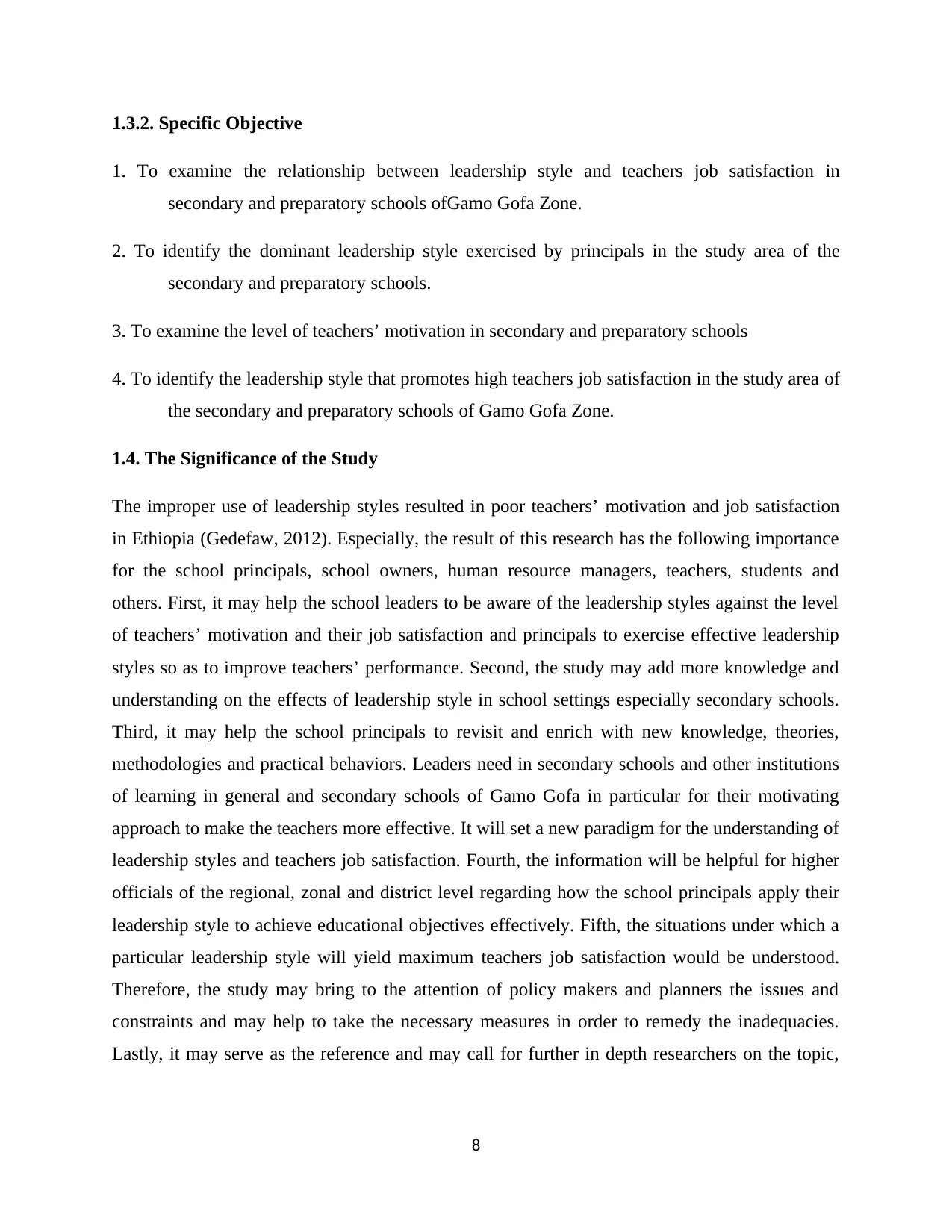
1.3.2. Specific Objective
1. To examine the relationship between leadership style and teachers job satisfaction in
secondary and preparatory schools ofGamo Gofa Zone.
2. To identify the dominant leadership style exercised by principals in the study area of the
secondary and preparatory schools.
3. To examine the level of teachers’ motivation in secondary and preparatory schools
4. To identify the leadership style that promotes high teachers job satisfaction in the study area of
the secondary and preparatory schools of Gamo Gofa Zone.
1.4. The Significance of the Study
The improper use of leadership styles resulted in poor teachers’ motivation and job satisfaction
in Ethiopia (Gedefaw, 2012). Especially, the result of this research has the following importance
for the school principals, school owners, human resource managers, teachers, students and
others. First, it may help the school leaders to be aware of the leadership styles against the level
of teachers’ motivation and their job satisfaction and principals to exercise effective leadership
styles so as to improve teachers’ performance. Second, the study may add more knowledge and
understanding on the effects of leadership style in school settings especially secondary schools.
Third, it may help the school principals to revisit and enrich with new knowledge, theories,
methodologies and practical behaviors. Leaders need in secondary schools and other institutions
of learning in general and secondary schools of Gamo Gofa in particular for their motivating
approach to make the teachers more effective. It will set a new paradigm for the understanding of
leadership styles and teachers job satisfaction. Fourth, the information will be helpful for higher
officials of the regional, zonal and district level regarding how the school principals apply their
leadership style to achieve educational objectives effectively. Fifth, the situations under which a
particular leadership style will yield maximum teachers job satisfaction would be understood.
Therefore, the study may bring to the attention of policy makers and planners the issues and
constraints and may help to take the necessary measures in order to remedy the inadequacies.
Lastly, it may serve as the reference and may call for further in depth researchers on the topic,
8
1. To examine the relationship between leadership style and teachers job satisfaction in
secondary and preparatory schools ofGamo Gofa Zone.
2. To identify the dominant leadership style exercised by principals in the study area of the
secondary and preparatory schools.
3. To examine the level of teachers’ motivation in secondary and preparatory schools
4. To identify the leadership style that promotes high teachers job satisfaction in the study area of
the secondary and preparatory schools of Gamo Gofa Zone.
1.4. The Significance of the Study
The improper use of leadership styles resulted in poor teachers’ motivation and job satisfaction
in Ethiopia (Gedefaw, 2012). Especially, the result of this research has the following importance
for the school principals, school owners, human resource managers, teachers, students and
others. First, it may help the school leaders to be aware of the leadership styles against the level
of teachers’ motivation and their job satisfaction and principals to exercise effective leadership
styles so as to improve teachers’ performance. Second, the study may add more knowledge and
understanding on the effects of leadership style in school settings especially secondary schools.
Third, it may help the school principals to revisit and enrich with new knowledge, theories,
methodologies and practical behaviors. Leaders need in secondary schools and other institutions
of learning in general and secondary schools of Gamo Gofa in particular for their motivating
approach to make the teachers more effective. It will set a new paradigm for the understanding of
leadership styles and teachers job satisfaction. Fourth, the information will be helpful for higher
officials of the regional, zonal and district level regarding how the school principals apply their
leadership style to achieve educational objectives effectively. Fifth, the situations under which a
particular leadership style will yield maximum teachers job satisfaction would be understood.
Therefore, the study may bring to the attention of policy makers and planners the issues and
constraints and may help to take the necessary measures in order to remedy the inadequacies.
Lastly, it may serve as the reference and may call for further in depth researchers on the topic,
8
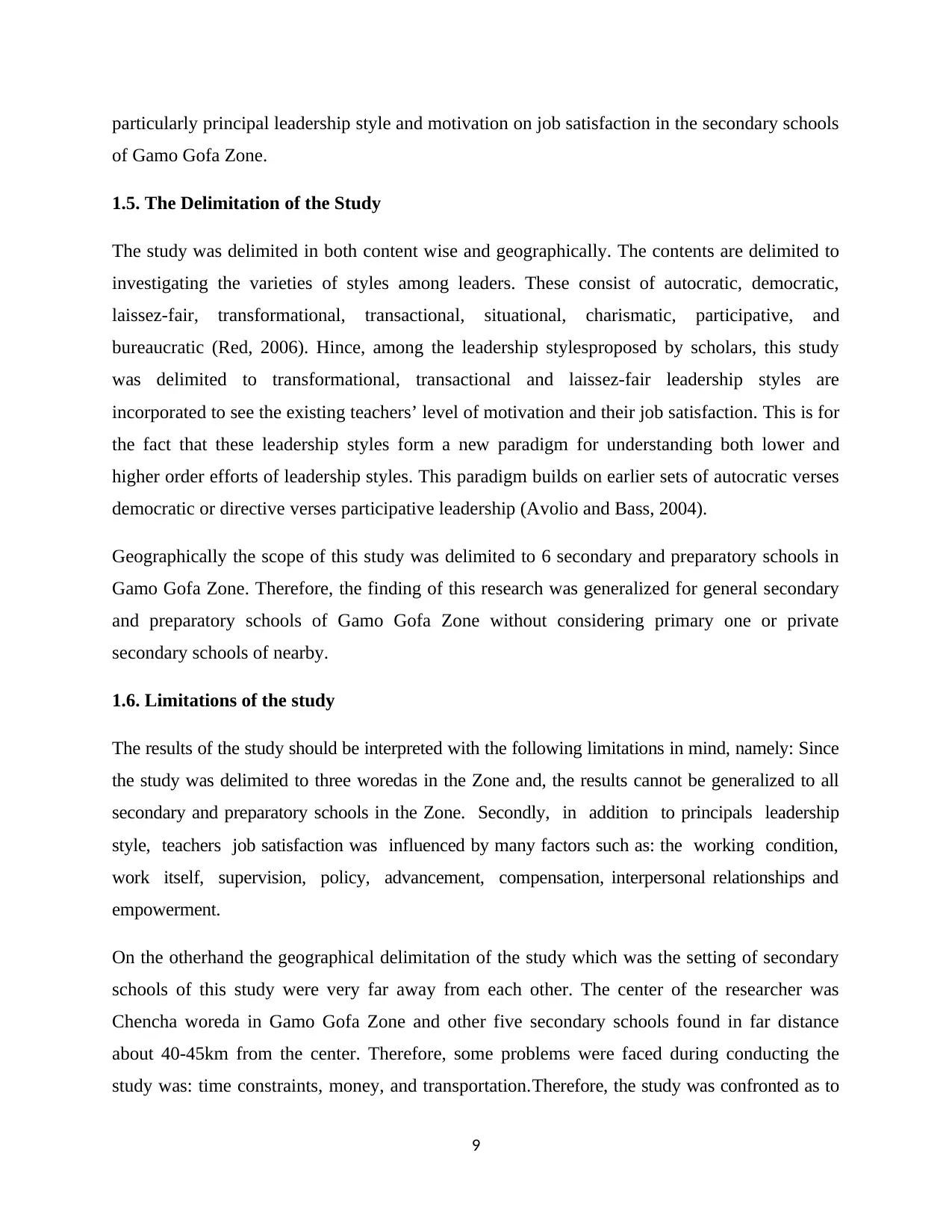
particularly principal leadership style and motivation on job satisfaction in the secondary schools
of Gamo Gofa Zone.
1.5. The Delimitation of the Study
The study was delimited in both content wise and geographically. The contents are delimited to
investigating the varieties of styles among leaders. These consist of autocratic, democratic,
laissez-fair, transformational, transactional, situational, charismatic, participative, and
bureaucratic (Red, 2006). Hince, among the leadership stylesproposed by scholars, this study
was delimited to transformational, transactional and laissez-fair leadership styles are
incorporated to see the existing teachers’ level of motivation and their job satisfaction. This is for
the fact that these leadership styles form a new paradigm for understanding both lower and
higher order efforts of leadership styles. This paradigm builds on earlier sets of autocratic verses
democratic or directive verses participative leadership (Avolio and Bass, 2004).
Geographically the scope of this study was delimited to 6 secondary and preparatory schools in
Gamo Gofa Zone. Therefore, the finding of this research was generalized for general secondary
and preparatory schools of Gamo Gofa Zone without considering primary one or private
secondary schools of nearby.
1.6. Limitations of the study
The results of the study should be interpreted with the following limitations in mind, namely: Since
the study was delimited to three woredas in the Zone and, the results cannot be generalized to all
secondary and preparatory schools in the Zone. Secondly, in addition to principals leadership
style, teachers job satisfaction was influenced by many factors such as: the working condition,
work itself, supervision, policy, advancement, compensation, interpersonal relationships and
empowerment.
On the otherhand the geographical delimitation of the study which was the setting of secondary
schools of this study were very far away from each other. The center of the researcher was
Chencha woreda in Gamo Gofa Zone and other five secondary schools found in far distance
about 40-45km from the center. Therefore, some problems were faced during conducting the
study was: time constraints, money, and transportation.Therefore, the study was confronted as to
9
of Gamo Gofa Zone.
1.5. The Delimitation of the Study
The study was delimited in both content wise and geographically. The contents are delimited to
investigating the varieties of styles among leaders. These consist of autocratic, democratic,
laissez-fair, transformational, transactional, situational, charismatic, participative, and
bureaucratic (Red, 2006). Hince, among the leadership stylesproposed by scholars, this study
was delimited to transformational, transactional and laissez-fair leadership styles are
incorporated to see the existing teachers’ level of motivation and their job satisfaction. This is for
the fact that these leadership styles form a new paradigm for understanding both lower and
higher order efforts of leadership styles. This paradigm builds on earlier sets of autocratic verses
democratic or directive verses participative leadership (Avolio and Bass, 2004).
Geographically the scope of this study was delimited to 6 secondary and preparatory schools in
Gamo Gofa Zone. Therefore, the finding of this research was generalized for general secondary
and preparatory schools of Gamo Gofa Zone without considering primary one or private
secondary schools of nearby.
1.6. Limitations of the study
The results of the study should be interpreted with the following limitations in mind, namely: Since
the study was delimited to three woredas in the Zone and, the results cannot be generalized to all
secondary and preparatory schools in the Zone. Secondly, in addition to principals leadership
style, teachers job satisfaction was influenced by many factors such as: the working condition,
work itself, supervision, policy, advancement, compensation, interpersonal relationships and
empowerment.
On the otherhand the geographical delimitation of the study which was the setting of secondary
schools of this study were very far away from each other. The center of the researcher was
Chencha woreda in Gamo Gofa Zone and other five secondary schools found in far distance
about 40-45km from the center. Therefore, some problems were faced during conducting the
study was: time constraints, money, and transportation.Therefore, the study was confronted as to
9
⊘ This is a preview!⊘
Do you want full access?
Subscribe today to unlock all pages.

Trusted by 1+ million students worldwide
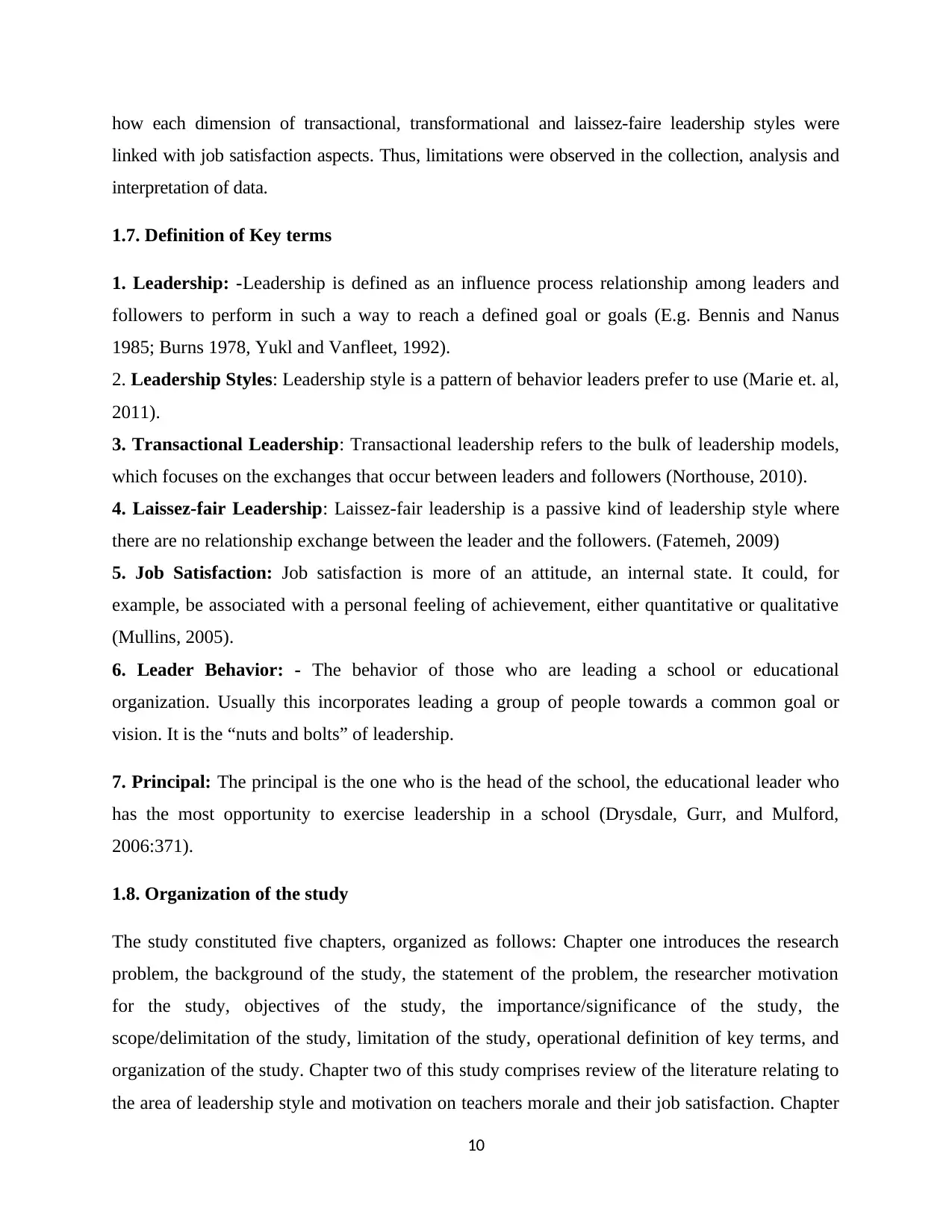
how each dimension of transactional, transformational and laissez-faire leadership styles were
linked with job satisfaction aspects. Thus, limitations were observed in the collection, analysis and
interpretation of data.
1.7. Definition of Key terms
1. Leadership: -Leadership is defined as an influence process relationship among leaders and
followers to perform in such a way to reach a defined goal or goals (E.g. Bennis and Nanus
1985; Burns 1978, Yukl and Vanfleet, 1992).
2. Leadership Styles: Leadership style is a pattern of behavior leaders prefer to use (Marie et. al,
2011).
3. Transactional Leadership: Transactional leadership refers to the bulk of leadership models,
which focuses on the exchanges that occur between leaders and followers (Northouse, 2010).
4. Laissez-fair Leadership: Laissez-fair leadership is a passive kind of leadership style where
there are no relationship exchange between the leader and the followers. (Fatemeh, 2009)
5. Job Satisfaction: Job satisfaction is more of an attitude, an internal state. It could, for
example, be associated with a personal feeling of achievement, either quantitative or qualitative
(Mullins, 2005).
6. Leader Behavior: - The behavior of those who are leading a school or educational
organization. Usually this incorporates leading a group of people towards a common goal or
vision. It is the “nuts and bolts” of leadership.
7. Principal: The principal is the one who is the head of the school, the educational leader who
has the most opportunity to exercise leadership in a school (Drysdale, Gurr, and Mulford,
2006:371).
1.8. Organization of the study
The study constituted five chapters, organized as follows: Chapter one introduces the research
problem, the background of the study, the statement of the problem, the researcher motivation
for the study, objectives of the study, the importance/significance of the study, the
scope/delimitation of the study, limitation of the study, operational definition of key terms, and
organization of the study. Chapter two of this study comprises review of the literature relating to
the area of leadership style and motivation on teachers morale and their job satisfaction. Chapter
10
linked with job satisfaction aspects. Thus, limitations were observed in the collection, analysis and
interpretation of data.
1.7. Definition of Key terms
1. Leadership: -Leadership is defined as an influence process relationship among leaders and
followers to perform in such a way to reach a defined goal or goals (E.g. Bennis and Nanus
1985; Burns 1978, Yukl and Vanfleet, 1992).
2. Leadership Styles: Leadership style is a pattern of behavior leaders prefer to use (Marie et. al,
2011).
3. Transactional Leadership: Transactional leadership refers to the bulk of leadership models,
which focuses on the exchanges that occur between leaders and followers (Northouse, 2010).
4. Laissez-fair Leadership: Laissez-fair leadership is a passive kind of leadership style where
there are no relationship exchange between the leader and the followers. (Fatemeh, 2009)
5. Job Satisfaction: Job satisfaction is more of an attitude, an internal state. It could, for
example, be associated with a personal feeling of achievement, either quantitative or qualitative
(Mullins, 2005).
6. Leader Behavior: - The behavior of those who are leading a school or educational
organization. Usually this incorporates leading a group of people towards a common goal or
vision. It is the “nuts and bolts” of leadership.
7. Principal: The principal is the one who is the head of the school, the educational leader who
has the most opportunity to exercise leadership in a school (Drysdale, Gurr, and Mulford,
2006:371).
1.8. Organization of the study
The study constituted five chapters, organized as follows: Chapter one introduces the research
problem, the background of the study, the statement of the problem, the researcher motivation
for the study, objectives of the study, the importance/significance of the study, the
scope/delimitation of the study, limitation of the study, operational definition of key terms, and
organization of the study. Chapter two of this study comprises review of the literature relating to
the area of leadership style and motivation on teachers morale and their job satisfaction. Chapter
10
Paraphrase This Document
Need a fresh take? Get an instant paraphrase of this document with our AI Paraphraser
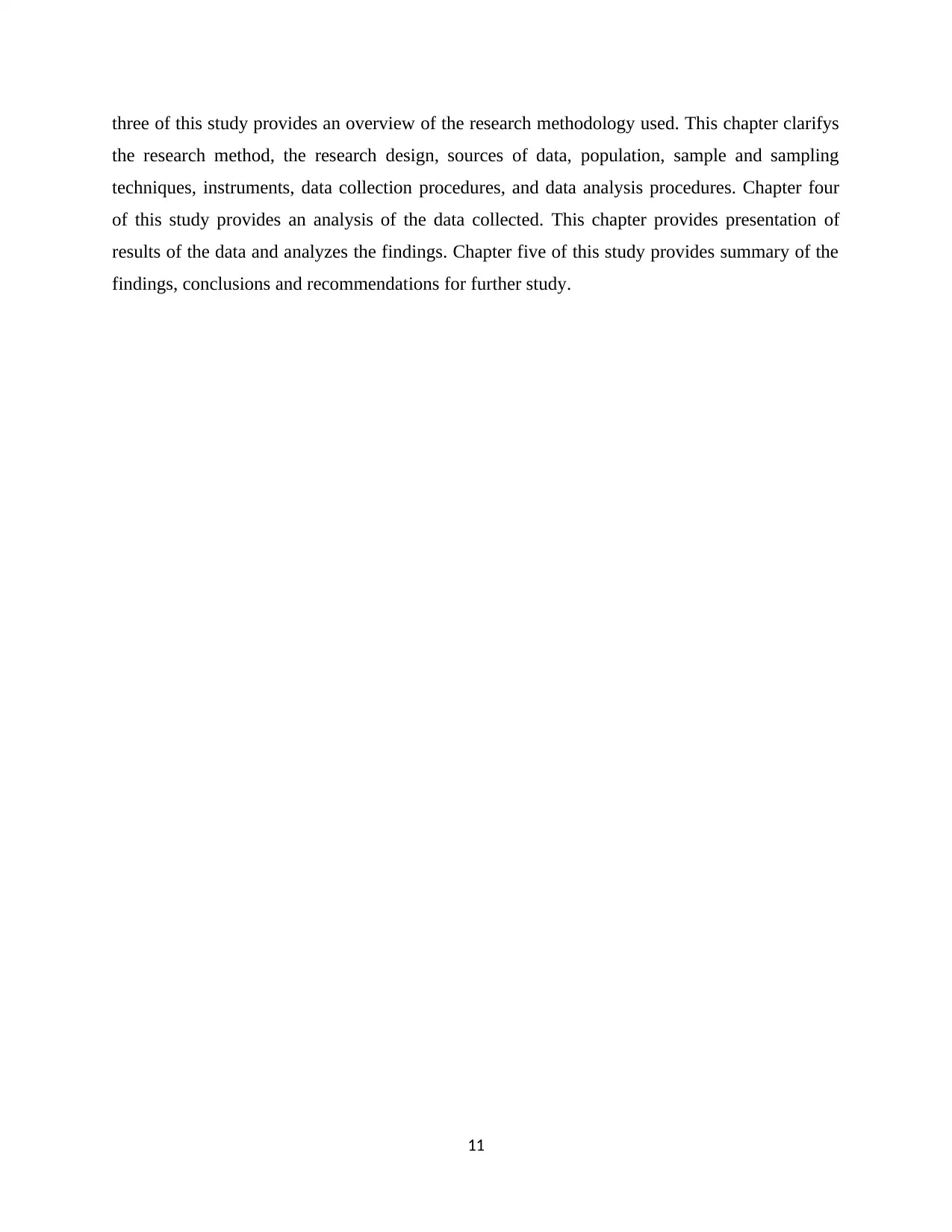
three of this study provides an overview of the research methodology used. This chapter clarifys
the research method, the research design, sources of data, population, sample and sampling
techniques, instruments, data collection procedures, and data analysis procedures. Chapter four
of this study provides an analysis of the data collected. This chapter provides presentation of
results of the data and analyzes the findings. Chapter five of this study provides summary of the
findings, conclusions and recommendations for further study.
11
the research method, the research design, sources of data, population, sample and sampling
techniques, instruments, data collection procedures, and data analysis procedures. Chapter four
of this study provides an analysis of the data collected. This chapter provides presentation of
results of the data and analyzes the findings. Chapter five of this study provides summary of the
findings, conclusions and recommendations for further study.
11
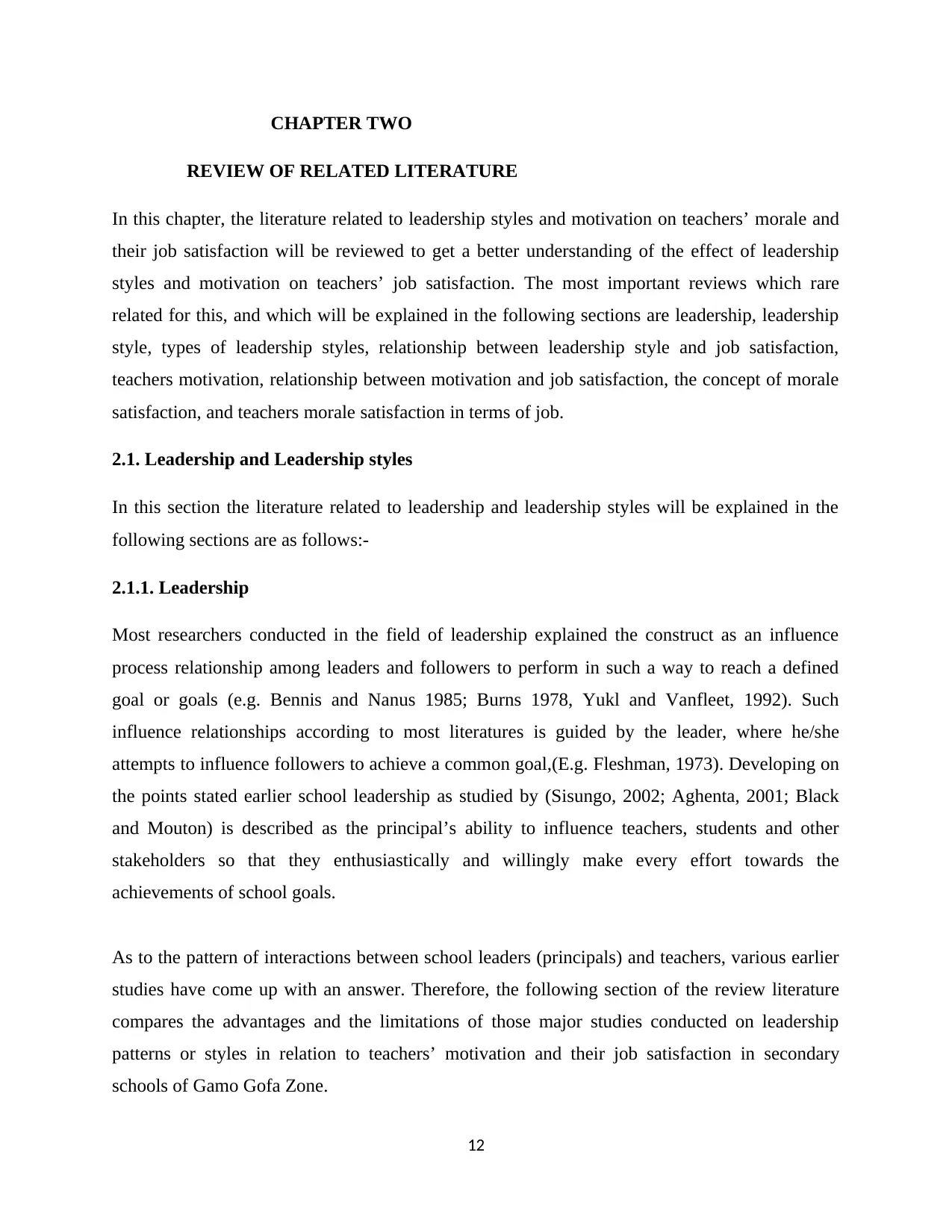
CHAPTER TWO
REVIEW OF RELATED LITERATURE
In this chapter, the literature related to leadership styles and motivation on teachers’ morale and
their job satisfaction will be reviewed to get a better understanding of the effect of leadership
styles and motivation on teachers’ job satisfaction. The most important reviews which rare
related for this, and which will be explained in the following sections are leadership, leadership
style, types of leadership styles, relationship between leadership style and job satisfaction,
teachers motivation, relationship between motivation and job satisfaction, the concept of morale
satisfaction, and teachers morale satisfaction in terms of job.
2.1. Leadership and Leadership styles
In this section the literature related to leadership and leadership styles will be explained in the
following sections are as follows:-
2.1.1. Leadership
Most researchers conducted in the field of leadership explained the construct as an influence
process relationship among leaders and followers to perform in such a way to reach a defined
goal or goals (e.g. Bennis and Nanus 1985; Burns 1978, Yukl and Vanfleet, 1992). Such
influence relationships according to most literatures is guided by the leader, where he/she
attempts to influence followers to achieve a common goal,(E.g. Fleshman, 1973). Developing on
the points stated earlier school leadership as studied by (Sisungo, 2002; Aghenta, 2001; Black
and Mouton) is described as the principal’s ability to influence teachers, students and other
stakeholders so that they enthusiastically and willingly make every effort towards the
achievements of school goals.
As to the pattern of interactions between school leaders (principals) and teachers, various earlier
studies have come up with an answer. Therefore, the following section of the review literature
compares the advantages and the limitations of those major studies conducted on leadership
patterns or styles in relation to teachers’ motivation and their job satisfaction in secondary
schools of Gamo Gofa Zone.
12
REVIEW OF RELATED LITERATURE
In this chapter, the literature related to leadership styles and motivation on teachers’ morale and
their job satisfaction will be reviewed to get a better understanding of the effect of leadership
styles and motivation on teachers’ job satisfaction. The most important reviews which rare
related for this, and which will be explained in the following sections are leadership, leadership
style, types of leadership styles, relationship between leadership style and job satisfaction,
teachers motivation, relationship between motivation and job satisfaction, the concept of morale
satisfaction, and teachers morale satisfaction in terms of job.
2.1. Leadership and Leadership styles
In this section the literature related to leadership and leadership styles will be explained in the
following sections are as follows:-
2.1.1. Leadership
Most researchers conducted in the field of leadership explained the construct as an influence
process relationship among leaders and followers to perform in such a way to reach a defined
goal or goals (e.g. Bennis and Nanus 1985; Burns 1978, Yukl and Vanfleet, 1992). Such
influence relationships according to most literatures is guided by the leader, where he/she
attempts to influence followers to achieve a common goal,(E.g. Fleshman, 1973). Developing on
the points stated earlier school leadership as studied by (Sisungo, 2002; Aghenta, 2001; Black
and Mouton) is described as the principal’s ability to influence teachers, students and other
stakeholders so that they enthusiastically and willingly make every effort towards the
achievements of school goals.
As to the pattern of interactions between school leaders (principals) and teachers, various earlier
studies have come up with an answer. Therefore, the following section of the review literature
compares the advantages and the limitations of those major studies conducted on leadership
patterns or styles in relation to teachers’ motivation and their job satisfaction in secondary
schools of Gamo Gofa Zone.
12
⊘ This is a preview!⊘
Do you want full access?
Subscribe today to unlock all pages.

Trusted by 1+ million students worldwide
1 out of 99
Related Documents
Your All-in-One AI-Powered Toolkit for Academic Success.
+13062052269
info@desklib.com
Available 24*7 on WhatsApp / Email
![[object Object]](/_next/static/media/star-bottom.7253800d.svg)
Unlock your academic potential
Copyright © 2020–2025 A2Z Services. All Rights Reserved. Developed and managed by ZUCOL.




